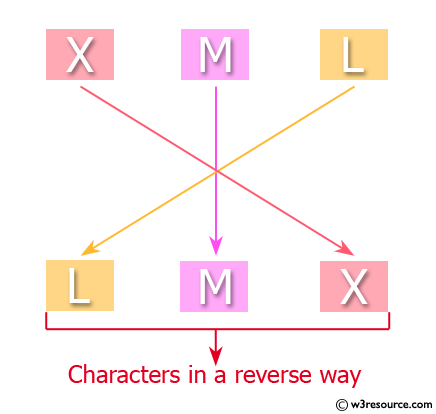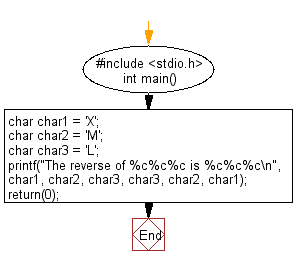C Exercises: Print characters in a reverse way
C Basic Declarations and Expressions: Exercise-4 with Solution
Write a C program to print the following characters in a reverse way.
Pictorial Presentation:

Test Characters : 'X', 'M', 'L'
C Code:
#include <stdio.h>
int main()
{
char char1 = 'X';
char char2 = 'M';
char char3 = 'L';
printf("The reverse of %c%c%c is %c%c%c\n",
char1, char2, char3,
char3, char2, char1);
return(0);
}
Sample Output:
The reverse of XML is LMX
Flowchart:

C Programming Code Editor:
Contribute your code and comments through Disqus.
Previous: Write a C program to print a big 'C'.
Next: Write a C program to compute the perimeter and area of a rectangle with a height of 7 inches. and width of 5 inches.
What is the difficulty level of this exercise?
Test your Programming skills with w3resource's quiz.
C Programming: Tips of the Day
Static variable inside of a function in C
The scope of variable is where the variable name can be seen. Here, x is visible only inside function foo().
The lifetime of a variable is the period over which it exists. If x were defined without the keyword static, the lifetime would be from the entry into foo() to the return from foo(); so it would be re-initialized to 5 on every call.
The keyword static acts to extend the lifetime of a variable to the lifetime of the programme; e.g. initialization occurs once and once only and then the variable retains its value - whatever it has come to be - over all future calls to foo().
Ref : https://bit.ly/3fOq7XP
- New Content published on w3resource:
- HTML-CSS Practical: Exercises, Practice, Solution
- Java Regular Expression: Exercises, Practice, Solution
- Scala Programming Exercises, Practice, Solution
- Python Itertools exercises
- Python Numpy exercises
- Python GeoPy Package exercises
- Python Pandas exercises
- Python nltk exercises
- Python BeautifulSoup exercises
- Form Template
- Composer - PHP Package Manager
- PHPUnit - PHP Testing
- Laravel - PHP Framework
- Angular - JavaScript Framework
- Vue - JavaScript Framework
- Jest - JavaScript Testing Framework
